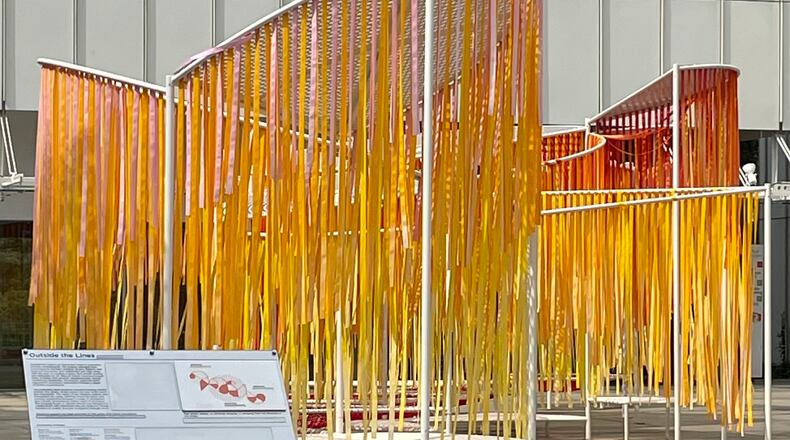Q: During one of my morning runs through Midtown I saw a structure hung with bright-colored strands outside of the HIGH Museum entrance. Can you tell me about this?
A: You are inquiring on the installation at the High Museum of Art entitled “Outside the Lines” on The Woodruff Arts Center’s Carroll Slater Sifly Piazza. It was designed for those with physical, developmental and/or intellectual disabilities.
This is the museum’s seventh-site specific installation and was created by Bryony Roberts.
“I really wanted to find someone who would highlight the roots of this endeavor. As I understood it, it was supposed to be an inclusive installation and encourage community engagement,” said Curator of Decorative Arts and Design Monica Obniski.
Obniski was familiar with Roberts’ work. “As an artist and architect, her projects are really rooted ... ,” she said. “I thought she could deliver artistically by creating something that was visually stunning which of course as an art museum we are super interested in, but also for me I thought she would intellectually deliver.”
An integral piece of Roberts’ design process is extensive collaboration and alliance. Roberts worked with “self-advocates with disabilities and their allies” to envision a piece that matched the piazza’s purpose, encouraged play and civic participation, she said.
“In talking with Bryony during her planning phase, our goal was to make the installation interesting from a multi-sensory perspective. That meant making sure there were interesting textures for kids to explore, interesting things to feel, ... like the hanging strands of different lengths. It also meant incorporating movement, like the net, which is also important and interesting for any child,” former Children & Youth Program Manager at the Center for the Visually Impaired Greg Aikens said.
“Sitara Nayak and myself were blessed to give input with assuring the event play structure was not only wheelchair accessible, but enjoyable for those with mobility challenges,” Director of Support Services for Parent to Parent of Georgia Mitzi Proffitt said.
OTL offers a play area through the incorporation of tactile elements for purposes of orientation, exploration, mobility, stimulation and open-ended play.
What first catches your eye are the multi-leveled pink, yellow, orange and red strands attached to the top of the curved steel installation. The strands divide the spaces to create pods. The open center area is considered the social zone that fosters playing, talking and provides additional seating through steel platforms at varying heights and red knotted nylon rope seating areas. Located on each end is a quiet zone designed for relaxing.
The installation is free, open to the public (not restricted to the museum’s hours) and is running through Nov. 28.
Address: 1280 Peachtree St. NE Atlanta.
New to Atlanta or simply have a question about this place we call home? Email your request to atlactualfact@gmail.com
About the Author
The Latest
Featured


